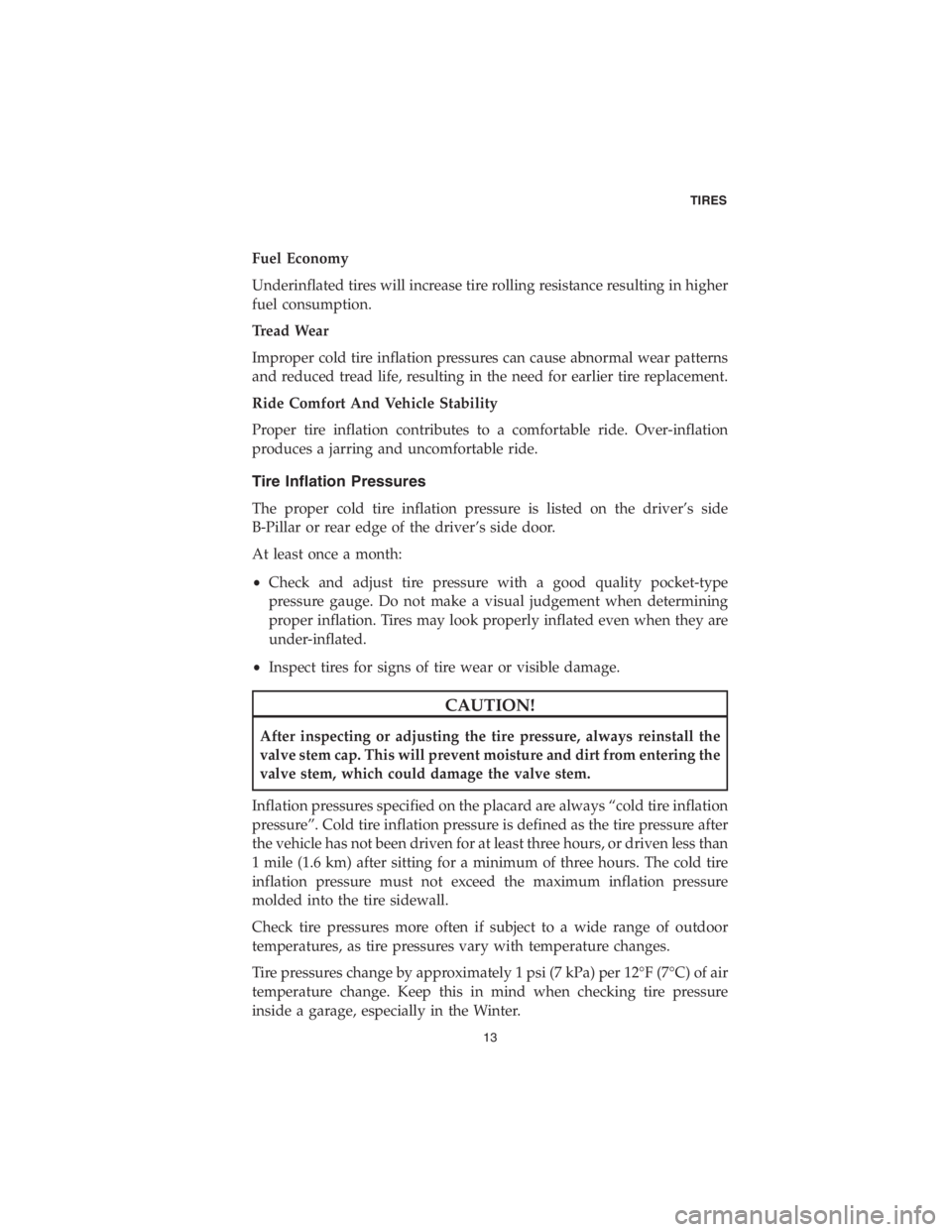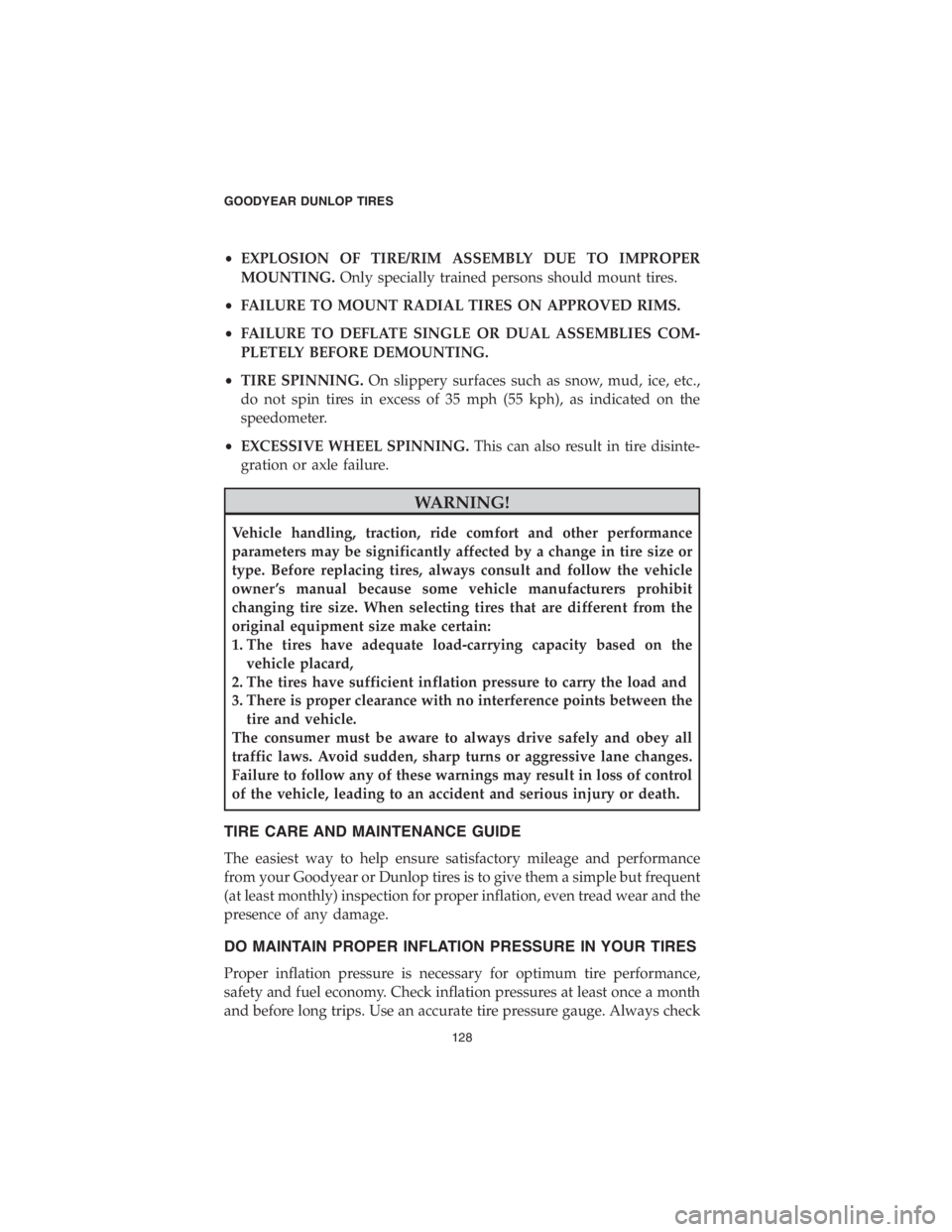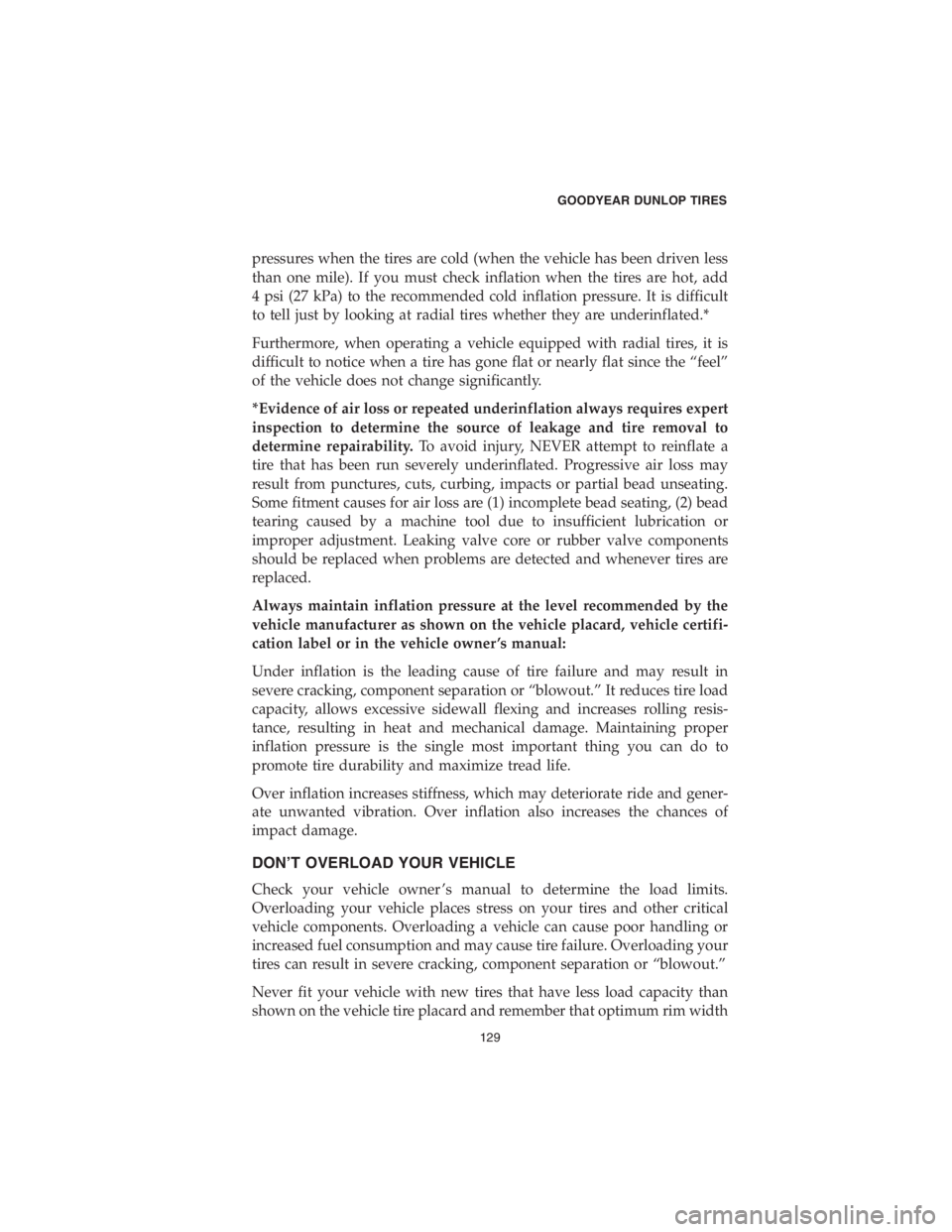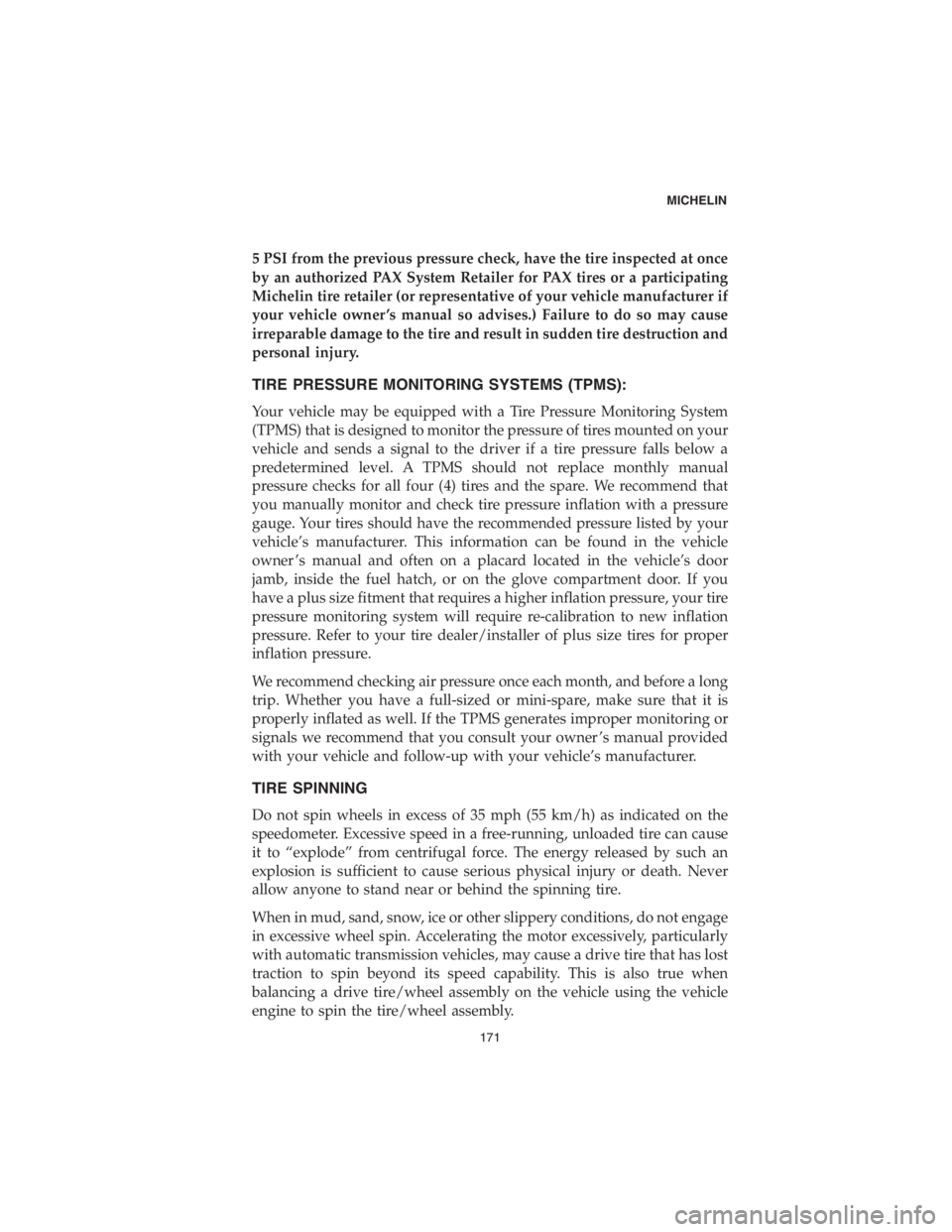fuel cap DODGE DURANGO 2018 Vehicle Warranty
[x] Cancel search | Manufacturer: DODGE, Model Year: 2018, Model line: DURANGO, Model: DODGE DURANGO 2018Pages: 316, PDF Size: 3.15 MB
Page 14 of 316

Fuel Economy
Underinflated tires will increase tire rolling resistance resulting in higher
fuel consumption.
Tread Wear
Improper cold tire inflation pressures can cause abnormal wear patterns
and reduced tread life, resulting in the need for earlier tire replacement.
Ride Comfort And Vehicle Stability
Proper tire inflation contributes to a comfortable ride. Over-inflation
produces a jarring and uncomfortable ride.
Tire Inflation Pressures
The proper cold tire inflation pressure is listed on the driver’s side
B-Pillar or rear edge of the driver’s side door.
At least once a month:
•Check and adjust tire pressure with a good quality pocket-type
pressure gauge. Do not make a visual judgement when determining
proper inflation. Tires may look properly inflated even when they are
under-inflated.
•Inspect tires for signs of tire wear or visible damage.
CAUTION!
After inspecting or adjusting the tire pressure, always reinstall the
valve stem cap. This will prevent moisture and dirt from entering the
valve stem, which could damage the valve stem.
Inflation pressures specified on the placard are always “cold tire inflation
pressure”. Cold tire inflation pressure is defined as the tire pressure after
the vehicle has not been driven for at least three hours, or driven less than
1 mile (1.6 km) after sitting for a minimum of three hours. The cold tire
inflation pressure must not exceed the maximum inflation pressure
molded into the tire sidewall.
Check tire pressures more often if subject to a wide range of outdoor
temperatures, as tire pressures vary with temperature changes.
Tire pressures change by approximately 1 psi (7 kPa) per 12°F (7°C) of air
temperature change. Keep this in mind when checking tire pressure
inside a garage, especially in the Winter.
TIRES
13
Page 129 of 316

•EXPLOSION OF TIRE/RIM ASSEMBLY DUE TO IMPROPER
MOUNTING.Only specially trained persons should mount tires.
•FAILURE TO MOUNT RADIAL TIRES ON APPROVED RIMS.
•FAILURE TO DEFLATE SINGLE OR DUAL ASSEMBLIES COM-
PLETELY BEFORE DEMOUNTING.
•TIRE SPINNING.On slippery surfaces such as snow, mud, ice, etc.,
do not spin tires in excess of 35 mph (55 kph), as indicated on the
speedometer.
•EXCESSIVE WHEEL SPINNING.This can also result in tire disinte-
gration or axle failure.
WARNING!
Vehicle handling, traction, ride comfort and other performance
parameters may be significantly affected by a change in tire size or
type. Before replacing tires, always consult and follow the vehicle
owner ’s manual because some vehicle manufacturers prohibit
changing tire size. When selecting tires that are different from the
original equipment size make certain:
1. The tires have adequate load-carrying capacity based on the
vehicle placard,
2. The tires have sufficient inflation pressure to carry the load and
3. There is proper clearance with no interference points between the
tire and vehicle.
The consumer must be aware to always drive safely and obey all
traffic laws. Avoid sudden, sharp turns or aggressive lane changes.
Failure to follow any of these warnings may result in loss of control
of the vehicle, leading to an accident and serious injury or death.
TIRE CARE AND MAINTENANCE GUIDE
The easiest way to help ensure satisfactory mileage and performance
from your Goodyear or Dunlop tires is to give them a simple but frequent
(at least monthly) inspection for proper inflation, even tread wear and the
presence of any damage.
DO MAINTAIN PROPER INFLATION PRESSURE IN YOUR TIRES
Proper inflation pressure is necessary for optimum tire performance,
safety and fuel economy. Check inflation pressures at least once a month
and before long trips. Use an accurate tire pressure gauge. Always check
GOODYEAR DUNLOP TIRES
128
Page 130 of 316

pressures when the tires are cold (when the vehicle has been driven less
than one mile). If you must check inflation when the tires are hot, add
4 psi (27 kPa) to the recommended cold inflation pressure. It is difficult
to tell just by looking at radial tires whether they are underinflated.*
Furthermore, when operating a vehicle equipped with radial tires, it is
difficult to notice when a tire has gone flat or nearly flat since the “feel”
of the vehicle does not change significantly.
*Evidence of air loss or repeated underinflation always requires expert
inspection to determine the source of leakage and tire removal to
determine repairability.To avoid injury, NEVER attempt to reinflate a
tire that has been run severely underinflated. Progressive air loss may
result from punctures, cuts, curbing, impacts or partial bead unseating.
Some fitment causes for air loss are (1) incomplete bead seating, (2) bead
tearing caused by a machine tool due to insufficient lubrication or
improper adjustment. Leaking valve core or rubber valve components
should be replaced when problems are detected and whenever tires are
replaced.
Always maintain inflation pressure at the level recommended by the
vehicle manufacturer as shown on the vehicle placard, vehicle certifi-
cation label or in the vehicle owner ’s manual:
Under inflation is the leading cause of tire failure and may result in
severe cracking, component separation or “blowout.” It reduces tire load
capacity, allows excessive sidewall flexing and increases rolling resis-
tance, resulting in heat and mechanical damage. Maintaining proper
inflation pressure is the single most important thing you can do to
promote tire durability and maximize tread life.
Over inflation increases stiffness, which may deteriorate ride and gener-
ate unwanted vibration. Over inflation also increases the chances of
impact damage.
DON’T OVERLOAD YOUR VEHICLE
Check your vehicle owner ’s manual to determine the load limits.
Overloading your vehicle places stress on your tires and other critical
vehicle components. Overloading a vehicle can cause poor handling or
increased fuel consumption and may cause tire failure. Overloading your
tires can result in severe cracking, component separation or “blowout.”
Never fit your vehicle with new tires that have less load capacity than
shown on the vehicle tire placard and remember that optimum rim width
GOODYEAR DUNLOP TIRES
129
Page 172 of 316

5 PSI from the previous pressure check, have the tire inspected at once
by an authorized PAX System Retailer for PAX tires or a participating
Michelin tire retailer (or representative of your vehicle manufacturer if
your vehicle owner ’s manual so advises.) Failure to do so may cause
irreparable damage to the tire and result in sudden tire destruction and
personal injury.
TIRE PRESSURE MONITORING SYSTEMS (TPMS):
Your vehicle may be equipped with a Tire Pressure Monitoring System
(TPMS) that is designed to monitor the pressure of tires mounted on your
vehicle and sends a signal to the driver if a tire pressure falls below a
predetermined level. A TPMS should not replace monthly manual
pressure checks for all four (4) tires and the spare. We recommend that
you manually monitor and check tire pressure inflation with a pressure
gauge. Your tires should have the recommended pressure listed by your
vehicle’s manufacturer. This information can be found in the vehicle
owner ’s manual and often on a placard located in the vehicle’s door
jamb, inside the fuel hatch, or on the glove compartment door. If you
have a plus size fitment that requires a higher inflation pressure, your tire
pressure monitoring system will require re-calibration to new inflation
pressure. Refer to your tire dealer/installer of plus size tires for proper
inflation pressure.
We recommend checking air pressure once each month, and before a long
trip. Whether you have a full-sized or mini-spare, make sure that it is
properly inflated as well. If the TPMS generates improper monitoring or
signals we recommend that you consult your owner ’s manual provided
with your vehicle and follow-up with your vehicle’s manufacturer.
TIRE SPINNING
Do not spin wheels in excess of 35 mph (55 km/h) as indicated on the
speedometer. Excessive speed in a free-running, unloaded tire can cause
it to “explode” from centrifugal force. The energy released by such an
explosion is sufficient to cause serious physical injury or death. Never
allow anyone to stand near or behind the spinning tire.
When in mud, sand, snow, ice or other slippery conditions, do not engage
in excessive wheel spin. Accelerating the motor excessively, particularly
with automatic transmission vehicles, may cause a drive tire that has lost
traction to spin beyond its speed capability. This is also true when
balancing a drive tire/wheel assembly on the vehicle using the vehicle
engine to spin the tire/wheel assembly.
MICHELIN
171